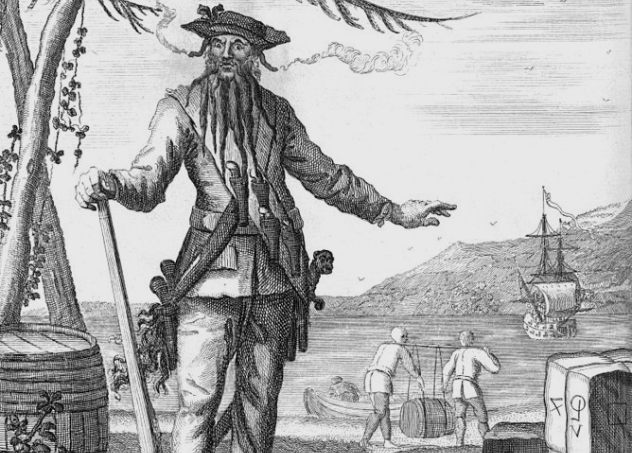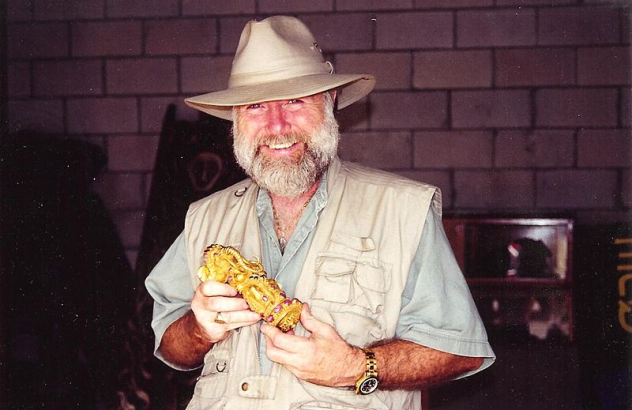 Our World
Our World  Our World
Our World  Movies and TV
Movies and TV The 10 Coolest Stars to Set Sail on The Love Boat
 History
History 10 Things You Didn’t Know About the American National Anthem
 Technology
Technology Top 10 Everyday Tech Buzzwords That Hide a Darker Past
 Humans
Humans 10 Everyday Human Behaviors That Are Actually Survival Instincts
 Animals
Animals 10 Animals That Humiliated and Harmed Historical Leaders
 History
History 10 Most Influential Protests in Modern History
 Creepy
Creepy 10 More Representations of Death from Myth, Legend, and Folktale
 Technology
Technology 10 Scientific Breakthroughs of 2025 That’ll Change Everything
 Our World
Our World 10 Ways Icelandic Culture Makes Other Countries Look Boring
 Our World
Our World 10 Ways Your Christmas Tree Is More Lit Than You Think
 Movies and TV
Movies and TV The 10 Coolest Stars to Set Sail on The Love Boat
 History
History 10 Things You Didn’t Know About the American National Anthem
Who's Behind Listverse?

Jamie Frater
Head Editor
Jamie founded Listverse due to an insatiable desire to share fascinating, obscure, and bizarre facts. He has been a guest speaker on numerous national radio and television stations and is a five time published author.
More About Us Technology
Technology Top 10 Everyday Tech Buzzwords That Hide a Darker Past
 Humans
Humans 10 Everyday Human Behaviors That Are Actually Survival Instincts
 Animals
Animals 10 Animals That Humiliated and Harmed Historical Leaders
 History
History 10 Most Influential Protests in Modern History
 Creepy
Creepy 10 More Representations of Death from Myth, Legend, and Folktale
 Technology
Technology 10 Scientific Breakthroughs of 2025 That’ll Change Everything
 Our World
Our World 10 Ways Icelandic Culture Makes Other Countries Look Boring
10 Stories Of Artifact Hunters Who Struck It Big
Treasure hunting has always been a venture for those who want to uncover history hidden from plain sight. From avid metal detector enthusiasts to explorers poring over maps and letters, treasure hunting has attracted people from all walks of life to search for ancient relics. While the obvious motivation for a treasure hunter is the riches that they might uncover, some people (including hunters on this list) hunt purely for archaeological purposes, the discovery of something long lost being reward enough. Here are 10 people who found what they were looking for—in a big way!
10 Philip Masters

Philip Masters passed away in the Bronx in 2007 at the age of 70. The story he left behind, however, was one of raw determination. His actions helped to locate the sunken ship of history’s most notorious pirate.
During the day, Masters appeared to be your average worker, albeit one with well-rounded resume. Some of his job titles included a cabdriver, a jewelry salesman, and a stockbroker. He also used his varied skills and his ability to learn new tricks for his nighttime and weekend hobby—tracking the wreck of the Queen Anne’s Revenge, Captain Blackbeard’s ship, which began its life as a French slave ship before Blackbeard (aka Edward Teach) took over ownership in 1717.
Finding a long-lost pirate ship wasn’t easy, but that didn’t deter Philip. He dug through 57 archival libraries for records and also learned Spanish so he didn’t need to rely on translations of source materials. In 1987, he finally found a lead in the rare book room of the New York Public Library. It was a book detailing both the trail of a pirate and an account of a lost pirate ship from 1718, the same year that Blackbeard’s ship went down.
Philip gathered a team of archaeologists, went to the site described, and hunted for the shipwreck. On November 1996, Philip and his team discovered a shipwreck that they believed to be the Queen Anne’s Revenge. There are no records of the ship being built, so the team couldn’t compare an initial design to the ship they had found. What they did discover, however, were 12 cannons, anchors, a bell, and 25 artifacts. Given that there are no other records of such a well-armed ship sinking in the area, this was enough to solidly prove that it had to be Blackbeard’s ship.
9 Dave Crisp
Dave Crisp had been metal detecting in fields since 1988. After finding a few Roman coins in a field in Frome, England, Dave believed that there was more hidden elsewhere in the field. Returning to the same location, he began his search once again to see if he could unearth a few more. His subsequent find satiated his hunt for “a few more coins” rather well; he found 52,503 of them, to be precise.
The coins were in a single pot and were dated to around AD 286–293, during the reign of the Roman emperor Carausius, who first brought the act of striking coins to Britain. A British Museum spokesman said that they believed the original intent of the hoard to be a religious offering of some kind.
The UK, however, has strict laws regarding discovery of treasure: The moment a find is recognized by its discoverer as treasure, they have two weeks to report the find to the British Museum, which will then determine if it is legally labeled as treasure or not. Once labeled, a market price is attached to it, and museums can pay that amount to include the finds in their collections.
Once an archaeological team had recovered the pot, the British Museum counted and dated each coin, and it was subsequently marked as treasure. They also declared it as the largest group of Carausius coins ever found, and the dig was named “The Frome Hoard.” It was valued at £320,250, which The Museum of Somerset paid. The money was split between Dave and the owner of the land where the hoard was found.
As for Dave, the expensive find didn’t spell the end for his hobby:
It’s just as exciting now as it was before, when you find something. The seemingly mundane finds, they transport you instantly to the moment it ended up in that field. Who was the person who lost it, what did that loss mean to them and what was the story behind it? It’s always fascinating.
8 Mel Fisher
After reading Treasure Island as a child, Mel decided that his goal would be to score a big find of his own within his lifetime. That set him on the path to establishing a diving business around 1953, to help people learn how to reach the depths, and airing TV shows of his underwater adventures on the then-young networks. He would accompany several divers in treasure hunts around the California coast, but the amount of discoveries he actually made was near nil.
A lead to great treasure presented itself after Mel met Kip Wagner in the 1960s. Kip discussed how he was trying to find the shipwrecks of the 1715 Spanish Treasure Fleet after finding silver coins washed up on the beach on the east coast of Florida’s. There was a problem, however: While Kip would have loved to go out and find where the coins were coming from, he didn’t have the crew, the time, or the money to perform a rigorous search. Mel offered to joint the hunt with his crew and split the profits 50–50 with Kip, which the latter agreed to. The resulting search for coins ended with over 1,000 of them being recovered from the sea.
That didn’t stop Mel, however. In 1969, he shifted his focus to a mother lode indicated in Potter’s Treasure Diver’s Guide—the Spanish galleon Nuestra Senora de Atocha, a royal guard galleon that sank off the Florida Keys carrying 40 tons of gold and silver. The hunt for the wreck would be hard, but Mel set his sights on finding the Atocha.
Over the next 16 years, Mel would track a trail of treasure back to its source: A silver bar with the Atocha’s manifest numbers etched on it was found in 1973, five bronze cannons were found in 1975, and 13 gold bars and gold jewellery were found on Memorial Day 1985. Finally, on July 20, 1985, they found the main hoard—1,041 silver bars and boxes containing 3,000 gold coins each. The whole find totaled up to $400 million in value.
The hunt for the treasure wasn’t without its costs, however. Throughout the hunt, Mel had lost money and crewmembers, and he racked up legal fees fighting off the US Supreme Court, which insisted that the wreck—and its treasure—was rightfully theirs. Mel would go on to found the Mel Fisher Maritime Heritage Society to protect the artifacts, which found a home in The Key West Museum.
7 E. Lee Spence

Another person who dreamed of treasure hunting since he was a child, Dr. E. Lee Spence’s treasure hunting career got off to a good start after he found his first shipwreck when he was 12. He eventually became one of the first people to receive a doctorate in the field of marine archaeology and is seen as one of the founding fathers of the field. Over the course of his career, Spence would find treasures of a different sort than simply gold and gems. His portfolio of finds contains many historical shipwrecks, such as the Confederate cruiser Georgiana and various pirate ships.
One of his best finds (by his own account) was the Confederate submarine H.L. Hunley, the first combat submarine in history to sink a ship during battle. Dr. William Dudley, the director of naval history at the Naval Historical Center, claimed that the discovery of the Hunley was probably the biggest underwater archaeological find of the 20th century. The Hunley was valued at $12 million, but Spence donated the rights to the find so that it would be raised and put on display for all to see.
6 Reg Mead And Richard Miles
Reg Mead and Richard Miles’ adventure began in the early 1980s, when they heard from a farmer’s daughter that her father had come across silver coins while working his fields in Jersey. Not wanting to leave a potential route to riches go unexplored, Reg and Richard expressed interest in digging around the area the coins were found.
There was a problem, however: While the field may have contained riches, it was still an active farming site. As such, the pair were allowed to investigate further, but under very strict conditions: They could only work in the area where the daughter thought the coins were found, and they could only dig in that area for 10–15 hours per year while the crops were being harvested. Such rules meant that the pair made slow but steady progress.
In 2012, their perseverance finally paid off. They discovered 50,000 Celtic and Roman coins, which would go on to be valued at £10 million. Immediately after the find, the UK government declared ownership according to the Treasure Trove law, but Jersey claimed that the law had no effect in the country any more. The problem was that without the UK’s treasure laws, Jersey was left without any legal process or definition for treasure, meaning that they had to make their own to better validate Reg and Richard’s find. As of September 2015, the hoard was still being picked through and analyzed.
Once the legal issues have been sorted and the coins all documented and accounted for, the landowner has agreed to split the funds between himself and the finders.
5 Miriam And Theo Siebenberg
Some people hunt for treasure; others simply end up living on top of it.
Miriam and Theo Siebenberg moved into their new home in Jerusalem’s Old City in 1970. At the time, an archaeological expedition was underway around the Old City to find buried relics. Curious, Theo asked the archaeologists about the potential of relics being found under the house they’d just bought. The archaeologists said that there probably wasn’t anything to find.
Theo disagreed with the notion, believing that there had to have been something built where his house currently stood. The couple hired a team to dig under the house. After eight months of digging, the team discovered a bronze key ring, the first sign that something may be waiting further down. After a bit more digging, they struck the mother lode—a wall from a 2,000-year-old home, baths, arrowheads, and burial chambers at least 2,600 years old.
Although the finds were highly valuable, the reason that Theo began digging was to better discover his roots. As such, instead of selling the treasures, the pair converted the bottom of the home into a museum for others to witness the dig site and artifacts below their home.
4 David Whelan
The story of how David Whelan found his haul begins as a humble outing with his son in a farm field near Harrogate, England, in 2007. While they were looking for trinkets, their metal detector picked something up. Curious, the pair got to digging and unearthed what looked like a simple bowl just over 0.3 meters (1 ft) into the soil. Per British law, David handed the bowl over to the authorities for treasure identification.
While the bowl itself was old, it wasn’t the reason why David and his son’s find rocked the archaeological world. It turned out that the bowl had been used as an improvised storage chest, within which was a trove of 600 Viking objects. The size of the horde made it the most important Viking find to date, and the origin of the objects spanned from locations such as Russia and France, showing how far-flung the Vikings’ invasions were. It’s believed that the trove was buried by a wealthy Viking leader for safekeeping. The horde was valued at around £1 million and was jointly purchased by the York Museum Trust and the British Museum.
3 Tommy Thompson
A deviation from the typical tale of an honorable and brave treasure hunter, Tommy Thompson made the headlines when he discovered the wreck of the SS Central America. The steamship was launched in 1852 and moved gold bars between New York and San Francisco during the California Gold Rush. A hurricane sank the ship in 1857. It took its precious cargo with it, making it a prime target for treasure hunters.
Enthused by the find of such a valuable haul, 161 investors helped finance Tommy’s excavation to the tune of $12.7 million. He managed to recover the gold bars. Once retrieved, Tommy’s haul was valued at $50 million. The investors believed that Tommy would pay them back for their investments as agreed. Instead, Tommy sold the bars and then vanished from public view.
After many legal battles and a search, he was eventually caught living in a Florida mansion with 12 disposable cell phones, a bank account under a pseudonym with $1 million, and a book on how to evade the law.
2 Terry Herbert
Born in 1954, Terry Herbert entered the treasure hunting world 14 years before his big find with nothing more than a metal detector he bought for £2.50 and a little bit of hope. Every time he went hunting for treasure in the fields, he would utter “spirits of yesteryear, take me where the coins appear.”
Whether the spirits of yesteryear finally listened or Terry struck it lucky, he began to uncover finds in a Hammerwich field owned by a farmer named Fred Johnson. In the space of five days, Terry would uncover more and more artifacts, storing them away as he went. He wasn’t so sure about what he was finding, however, so he decided to report his discovery to a finds liaison officer.
The artifacts he’d dug up were noted to be of historical value, so Birmingham Archaeology asked for, and received, permission from Fred to dig deeper. The result was a 1,662-object hoard, labeled as the biggest Anglo-Saxon hoard discovered to date. It was valued at £3.28 million and subsequently sold to Birmingham Museum and Potteries Museum.
While both Terry and Fred saw an equal share of the payout, the find ended up breaking the pair apart. Both sides accused the other of being greedy and wanting to keep the majority of the payout for themselves, to the point where Fred had to ban Terry from entering his land again.
1 Paul Coleman
An avid member of the Weekend Wanderers Detecting Club in Buckinghamshire, England, Paul Coleman made a discovery that ended up being the biggest that the club had ever seen.
It began when Paul was taking part in the club’s end-of-the-year rally, which was held at a field near Aylesury on December 21, 2014. While scanning the earth, his metal detector picked up something massive underneath. Much digging revealed a layer of coins within a lead sheet acting as a bucket, buried 0.6 meters (2 ft) down. As soon as Paul came across it, he knew he had stumbled onto something big.
While the bucket was being dug up, Pete Welch, the club’s owner for 23 years, took a look at the coins and noted how well-preserved they were. “They’re like mirrors, no scratching, and buried really carefully in a lead container, deep down,” he said. “It looks as though only two people have handled these coins. The person who made them and the person who buried them.”
The coins were taken to the British Museum, where it was announced that the hoard totaled around 5,000 coins. Believed to have been buried for safekeeping, the faces on the coins were either of Aethelred II (978–1016) or Cnut (1016–35). That means that the coins were gathered and hidden around when Cnut’s reign was ending, sometime around 1035. The pile was valued at an estimated £1.3 million and still undergoing evaluation and cataloguing by the British Museum. Museums are already stepping forward with money to try to purchase some of the hoard for their own collections.
S.E. Batt is a freelance writer and author. He enjoys a good keyboard, cats, and tea, even though the three of them never blend well together. You can follow his antics over at @Simon_Batt or his fiction website at www.sebatt.com.








